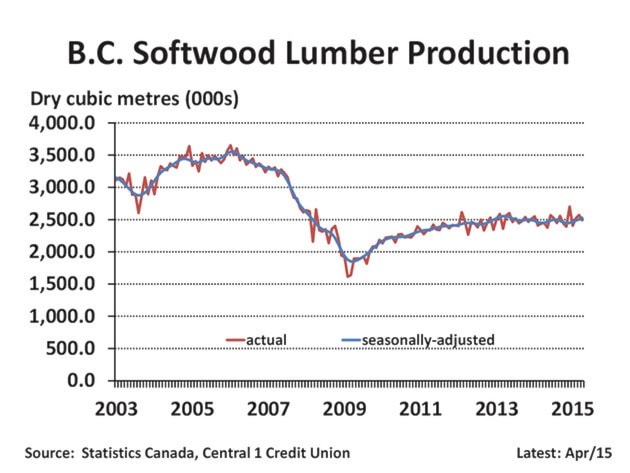Bryan Yu
This is not the forestry recovery that was hoped for.
B.C.’s lumber production has long been considered a sector that would contribute positively and significantly to provincial economic growth in the post-recession period, with U.S. economic growth and increased home building the key triggers for higher lumber export demand.
Despite U.S. housing starts rebounding to over one million units in 2014 from about 609,000 in 2011, and grinding out year-to-date growth of six per cent this year, B.C. lumber production remains in a disappointing holding pattern.
Monthly production is trundling along at pace that is not all that different from the average level observed since 2012. In April, monthly production of softwood lumber was up 1.7 per cent from a year ago to 2.67 million dry cubic metres, pushing year to-date production growth to a lacklustre 1.5 per cent.
Part of this year’s production growth reflects increased capacity due to the restart of rebuilt mills in Prince George and Burns Lake. This aligns with dollar-volume manufacturing growth of sawmill and wood preservation products of 3.7 per cent over the same period with the differential owing in part to mild price growth over the period. Lumber shipment gains have lagged growth in broader wood-product manufacturing activity of about eight per cent year to-date, which includes products like veneer, plywood engineered-wood, pellets, and other products.
While a seemingly contradictory (and rosier) picture emerges with the growth in year-to-date physical exports of softwood lumber to international markets of 13 per cent through April, the outsized gain reflects base-year effects. Exports were curtailed sharply in early 2014 during the Metro Vancouver port strike.
Similar to production, the underlying month-to-month export trend has generally held range-bound, despite the strong year-over-year gain.
The frustratingly slow rebound in lumber activity is a mild downside risk for our provincial growth outlook and reflects a number of factors. On the U.S. front, while housing starts are grinding higher, and are anticipated to pick up steam, exports have not kept pace. B.C. mills face significant competition from southern U.S. producers for market share and a low price environment. Benchmark prices have fallen to the lowest levels since 2012.
While the low Canadian dollar has provided some cushion north of the border, low prices have triggered export charges under the softwood lumber agreement. In April, the B.C. export charge rate was five per cent – downward pricing momentum through the second quarter has lifted the B.C. export charge rate to 10 per cent in June and 15 per cent in July.
Meanwhile, export demand from China, which has surged six-fold since the recession and provided a needed cushion following the U.S. housing bust, has softened. Slowing economic growth in China, a weaker housing market, and elevated global supply and lower prices for logs and lumber have conspired against growth in B.C. exports.
Domestically, Canadian housing starts are also showing little momentum, which is unlikely to change given the current soft patch in the economy.
Going forward, we see some abatement of current headwinds for the sector. Rising U.S. housing starts are anticipated to lift B.C. exports even if market share remains a challenge. Current consensus has U.S. starts rising about seven per cent this year and 14 per cent next. Meanwhile, loosening of restrictive housing policies in China and recent cuts to benchmark interest rates should support the housing market.
Forestry is forecast to be a shallow growth driver for B.C. over the next few years. Improved demand will lift direct forestry activity in B.C. to grow about two per cent this year with mild growth in 2016 and 2017. Manufactured wood products will fare better with growth averaging 2.5 per cent through 2017.
Growth will, however, be temporary given undeniable supply constraints in B.C. that will limit growth near the end of the decade. The mountain pine beetle epidemic has permanently lowered timber supply in the province, which will constrain the availability of fibre for B.C. mills – setting the stage for further mill and timber rights consolidation.
Additionally, the expiration of the existing 2006 Canada/U.S. SoftwoodLumber Agreement in October is sure to add further instability to the sector as political rhetoric ramps up to move to a new agreement. While operations will be unchanged during a year-long cooling off period (if an agreement is not reached in the interim), it could trigger investment uncertainty in the sector.
– Bryan Yu is a senior economist, BC Central 1 Credit Union
